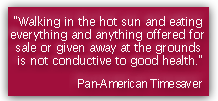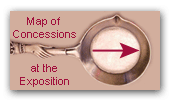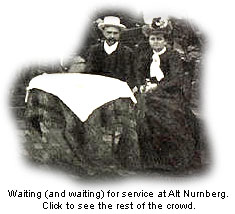 A
hungry person was rarely more than a few steps from something to eat on
the Exposition grounds. By the end of July, Sanitary Inspector Dr. Nelson
W. Wilson reported that there were 36 restaurants, 15 kitchens in concessions
and villages, and 57 soft drink stands on the grounds. A
hungry person was rarely more than a few steps from something to eat on
the Exposition grounds. By the end of July, Sanitary Inspector Dr. Nelson
W. Wilson reported that there were 36 restaurants, 15 kitchens in concessions
and villages, and 57 soft drink stands on the grounds.
Liesurely Dining
Of these, there were 9 large restaurants managed by the Bailey Catering
Company near the entrances and in the Electric Tower. See sample menus here.There were also numerous
eateries in the various Midway buildings such as Alt Nurnberg, the Streets
of Mexico, the Indian Congress, Beautiful Orient, Philippine Village, Fair
Japan, Scenic Railway, Venice in America and the Pabst Pavilion. People
today are not surprised to be able to choose from Italian, Japanese, German,
Middle Eastern or Mexican foods, but for 1901 people this was a stunning
amount of variety.
The Rice Association of America sponsored a popular
Louisiana Rice Kitchen near the state and foreign buildings. The Nebraska Sod
House was also a money-maker, despite being repeatedly written up and even closed
down by the Pan-American Sanitary Office for unsanitary conditions. Individual
concessionaires included Firmin Michel's Roast Beef Sandwiches, the Wellington,
the American Inn. Mrs. McCready's Restaurant was touted in a guide book thus:
"Here the visitor may procure foods of any description to satisfy 'the
inner man.' A first-class restaurant in every particular and assured of a high-class
patronage."
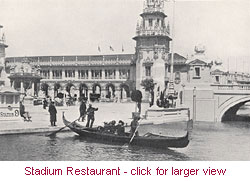 These
were "sit-down" restaurants, where you could get table service.
How much did it cost a foot-sore person who needed to sit down (in the shade,
preferably) and didn't mind paying for the privilege? The charges varied
widely, but most agree that the two most expensive places to eat on the
ground were the Electric Tower restaurant (the higher of the two restaurants
charged the higher prices) and Alt Nurnberg, a Buffalo concession that brought
in famed New York restauranteur August Luchow (of Luchow's) to manage the
restaurant. A frankfurter at Alt Nurnberg cost $.45 ($9.00 in today's money);
whether a bun was included is not known! A cup of coffee at one of the Bailey
Catering Concession restaurants cost $.10 ($2.00); if one had any money
left over from the coffee, some pie baked in the Exposition
Kitchen on the grounds might be a fine accompaniment. These
were "sit-down" restaurants, where you could get table service.
How much did it cost a foot-sore person who needed to sit down (in the shade,
preferably) and didn't mind paying for the privilege? The charges varied
widely, but most agree that the two most expensive places to eat on the
ground were the Electric Tower restaurant (the higher of the two restaurants
charged the higher prices) and Alt Nurnberg, a Buffalo concession that brought
in famed New York restauranteur August Luchow (of Luchow's) to manage the
restaurant. A frankfurter at Alt Nurnberg cost $.45 ($9.00 in today's money);
whether a bun was included is not known! A cup of coffee at one of the Bailey
Catering Concession restaurants cost $.10 ($2.00); if one had any money
left over from the coffee, some pie baked in the Exposition
Kitchen on the grounds might be a fine accompaniment.
These tidbits and other rumors quickly gave
rise to the notion that one could not get anything reasonably priced to
eat on the Exposition grounds. That was not necessarily correct overall,
as will be seen in the next section, but it must be understood that all
concessions at the Exposition were licensed and paid 25% of their profits
to the Exposition Company.
Fast Food
Numerous small concessions were scattered across the Exposition grounds
and inside buildings that provided sustenance to fuel the visitor without
breaking his or her budget. It was easy to get a lunch for $.25 - $.50 ($5.00
- $10.00) at a lunch counter featuring stools. If you didn't need to sit
down, you could purchase a sandwich and beverage (coffee, tea, or milk)
for $.15 ($3.00) and wander to one of the 18,000 spaces on benches to eat
it. Hard-boiled eggs could be had for 5 cents (the author suggests paying
10 cents to be sure they are not spoiled), and foods familiar to modern
people included chowder and beans. Nowhere is there mention of a green salad,
although there was a fruit concession run by J. A. McGinnis. For those who
believe in the food value of snack food, it was hard to miss the popcorn
boy calling out his wares, or the peanut vendors, and no one in July would
want to miss the ice cream stands, even if cones wouldn't be invented for
another 3 years.
Free Food
The best time to tour the Manufactures and Liberal Arts Building was around
lunchtime because you could save yourself the cost of lunch by munching
on manufacturers' samples in the Food Division. Almost everything was available,
from soup, meat, bread, cakes, fruit and mineral waters. Here is an observer's recounting.
Bringing Your Own
The "box lunch" was a universal
favorite method for Exposition visitors to bring their own lunch and thereby
guarantee some economy and degree of sanitation to their gustatory experiences.
The first mention of the box lunch appears in the News on May 21, the day
after the enormous attendance of Dedication Day. Amid the "ocean of
litter" left behind were a several thousand old shoe boxes that had
carried lunches for the visitors and were discarded.
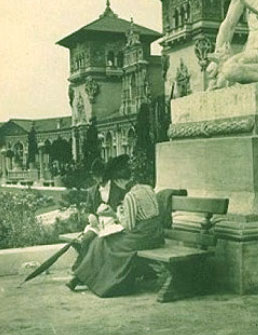 Box
lunches were also a mainstay of the frugal travelers to the Exposition by train.
From Ohio and points west and south rail travelers entered the Exposition and
immediately found their way to their state's building on the grounds. There
they deposited their box lunches for later consumption. There is no information
on what kinds of food were packed for what would have been a 12-24 hour period
without refrigeration. Box
lunches were also a mainstay of the frugal travelers to the Exposition by train.
From Ohio and points west and south rail travelers entered the Exposition and
immediately found their way to their state's building on the grounds. There
they deposited their box lunches for later consumption. There is no information
on what kinds of food were packed for what would have been a 12-24 hour period
without refrigeration.
And visitors could purchase a box lunch at a
number of city restaurants which they could then carry to the grounds.
Food Safety
Expositions and world's fairs in the 19th century were subject to all kinds
of rumors about poor health conditions which in many cases proved accurate.
These were particularly damaging to the companies invested in the success
of these enterprises because there were no cures for typhoid, tuberculosis,
ptomaine and salmonella, or from any diseases arising from e. coli or staphyloccocus bacteria. The additional challenges posed by any
food provider in 1901, namely lack of electric-powered refrigeration, made
it a challenge to keep foods sanitary in both uncooked and cooked condition.
Based on his surveys of past expositions and fairs, Exposition Medical Director
Roswell Park, M.D., determined to prevent the outbreak of disease wherever
possible at the Pan-American Exposition. His extensive planning resulted
in success in this, despite the nearly 2,000 visitors reporting to the Exposition
Hospital with 'digestive' complaints. For more details on inspection methods
of Exposition concessionaires by his medical team, see
Dr. Park's report.
Advice
Guidebooks tried to maintain some impartiality regarding eating establishments
on the grounds by speaking generally about locations and vendors. But magazine
writers were under no such restriction and could freely comment on what seemed
expensive or tasty. Here is one opinionated author' advice. An observant commentator describes business at the small food concessions here.
New Foods
Here is an article from the Boston Cooking School's magazine, "American Cookery" (October 1901), which Mrs. L.O. Harris
describes the types of foods she encountered at the Exposition.
|

